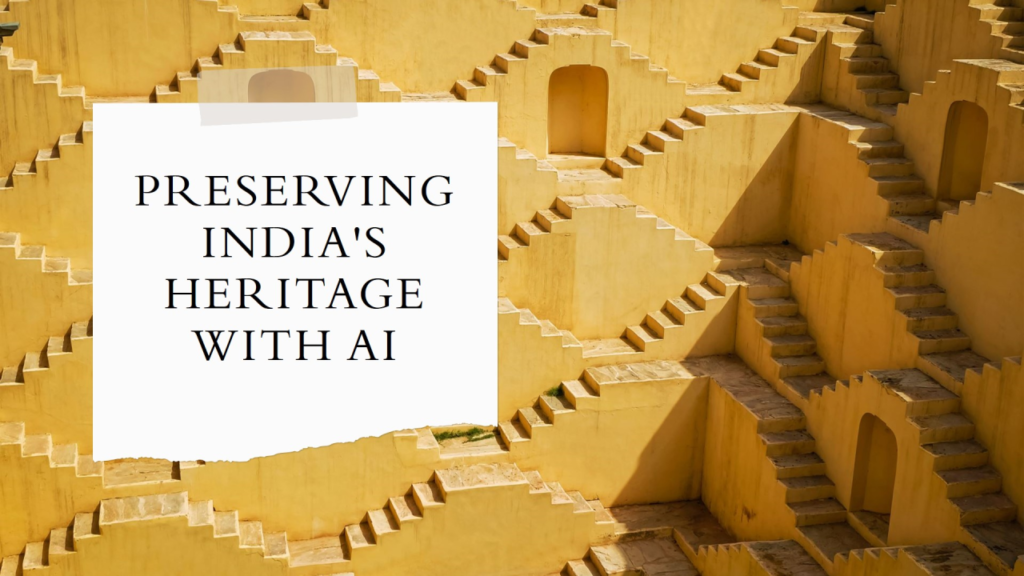How India Can Leverage AI to Digitally Preserve Heritage, Create Jobs, and Boost Economic Growth

India, with its diverse cultural landscape and unique heritage across states, has an incredible opportunity to use artificial intelligence (AI) to capture, preserve, and promote its vast cultural wealth. By adopting AI-driven digital strategies, states can create new job opportunities, strengthen tourism, and drive economic growth. Kerala provides a compelling example, showcasing how every Indian state can use technology to protect and share its cultural legacy with a global audience.
Here’s how India can lead in cultural preservation using AI, creating a nationwide framework that other states can replicate:
1. Content Collection and Curation
Every state has its unique blend of traditions, festivals, languages, and culinary practices. A concerted effort to digitally capture these can build a digital library of India’s rich heritage.• Visual Documentation: Use high-resolution photography, videography, and 3D scanning to document landmarks, temples, historical sites, and local festivals. For example, Kerala can capture Kathakali and Mohiniyattam performances in vivid detail. Other states can document their own traditional dances, landscapes, and architectures to create a diverse repository.
• Oral Histories and Narratives:
Record stories, folklore, and songs that reflect each state’s history. Capturing oral narratives in Tamil Nadu, Rajasthani folklore, or northeastern tribal traditions can preserve India’s intangible cultural assets.
• Language and Literature:
Digitize regional literature, poetry, and folk songs in languages like Malayalam, Tamil, Bengali, and Marathi. Translations can ensure that AI models can process the cultural nuances of each state.
• Culinary Heritage:
Record regional recipes and cooking techniques, from Kerala’s sadhya to Punjab’s parathas, highlighting the diversity of Indian cuisine. Video content and narrative can preserve these culinary traditions while making them globally accessible.
2. Cultural and Linguistic Modeling
• Language Models for Regional Languages:
Develop AI models in languages like Malayalam, Tamil, Kannada, and Hindi to capture local dialects, idioms, and historical context, making it easier for AI to understand India’s linguistic diversity.
• Computer Vision for Art and Architecture:
Train AI models to recognize art styles, architecture, and traditional designs across states. For example, Kerala’s temple architecture and mural art can be cataloged, just as Rajasthan’s forts and Gujarat’s stepwells can be digitally preserved for VR experiences.
3. Organized Data Framework for AI Learning
• Heritage Ontologies:
Create structured databases that connect cultural elements like art, folklore, music, and architecture for every state, making it easier for AI to understand relationships and patterns within India’s cultural ecosystem.
• Metadata Tagging:
Enrich content with metadata on historical context, location, and cultural significance. This provides AI with deeper insights into each artifact’s importance, making AI-driven applications like virtual museums more informative.
• Dynamic Data Models:
Use machine learning to adapt digital cultural records as they evolve. This way, the dynamic aspects of Indian culture can be preserved for future generations.
4. Monetization Opportunities
AI-powered digital transformation can open various monetization opportunities across states:
• Cultural Tourism Platforms:
Offer virtual and AR/VR-based tourism experiences that showcase India’s diverse heritage. Tourists can virtually visit Kerala’s backwaters, Madhya Pradesh’s temples, and Kashmir’s valleys.
• Educational Content:
Develop AI-driven educational content for schools and universities worldwide. Modules on Indian history, language, and art can cater to global audiences interested in learning about India.
• AI-Powered Art and Merchandise:
Use AI to create state-inspired art, merchandise, or NFTs reflecting traditional patterns and symbols. Kerala-inspired designs could include Kathakali masks, while Rajasthan’s would reflect royal motifs, appealing to a global market.
• Translation and Localization Services:
Create language tools to provide translations and cultural localization for businesses entering regional markets, helping them authentically engage with India’s linguistic diversity.
5. Community and Stakeholder Involvement
Engaging local communities and stakeholders ensures that India’s digital heritage projects remain accurate and sustainable:
• Collaborate with Cultural Institutions:
Work with museums, universities, and cultural bodies to ensure authenticity in digital content. Kerala’s cultural institutions can validate traditional arts, while every state can engage its local experts.
• Incentivize Local Content Creation:
Encourage local artists, historians, and tech enthusiasts to document their heritage, building a robust AI training dataset.
• Ethical and Inclusive Data Usage:
Ensure all content respects cultural integrity, with guidelines to protect intellectual property and community rights.Building a Digital India for Global Cultural ExchangeThis approach can create a robust, AI-driven ecosystem to preserve India’s diverse cultural heritage while boosting job opportunities in AI, digital media, tourism, and education.
By creating virtual experiences and accessible content, India can enhance its status as a cultural powerhouse, attracting global tourism and promoting cultural understanding on a worldwide scale.
Conclusion
Every Indian state has unique cultural wealth that can be captured, preserved, and monetized through AI. As Kerala leads by example, other states can adopt this framework, empowering India to become a leader in digital cultural preservation. This digital transformation will create thousands of new job opportunities, drive revenue from cultural tourism, and position India as a global hub for cultural AI innovation.






Responses